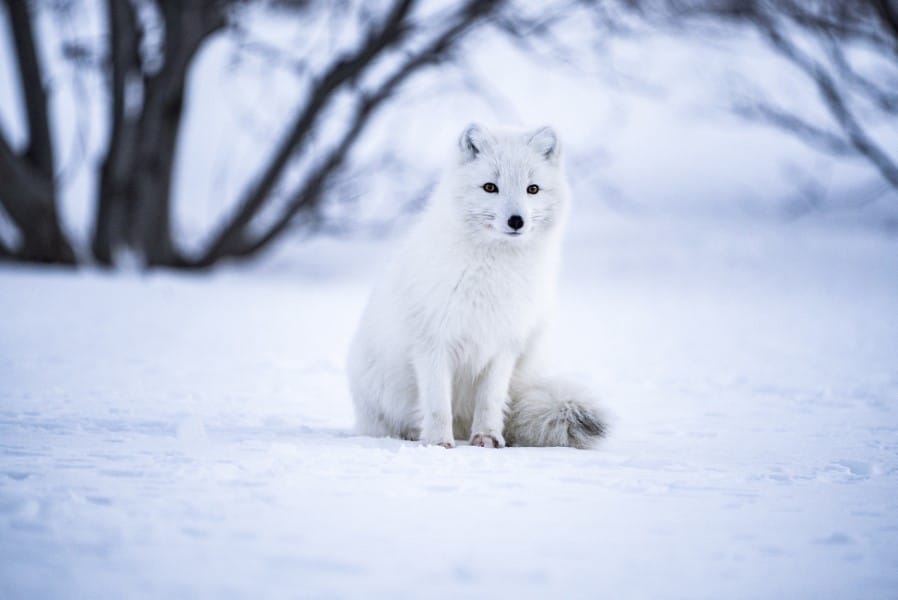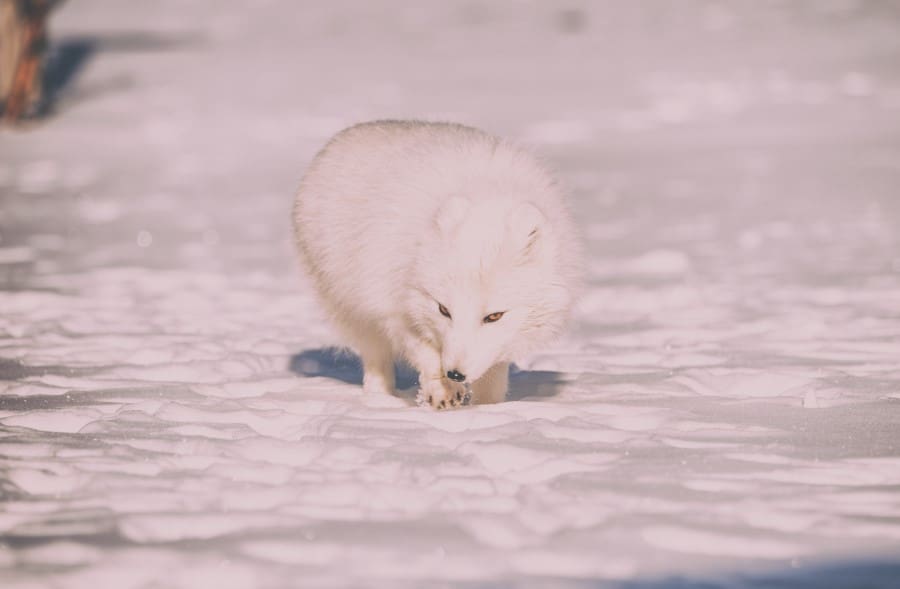Arctic foxes are, of course, very cute, and in fact, are largely unseen by most, but have you ever wondered exactly what arctic foxes eat? Well, this article will walk you through what arctic foxes eat in the mild, as well as the extremely cold habitats and environments they live in.
What Do Arctic Foxes Eat? Arctic foxes are omnivores and so eat both animals and plants. Lemmings and white geese are part of their staple diet. Apart from these, they eat a collection of fruits, eggs of birds, marine animals, and invertebrates. During winter they mostly eat the food they stored and buried in previous months.
Arctic foxes are one of those animals that are still considered under-researched, mainly due to the extreme temperate environments they live in.
So, many arctic fox behaviors still remain a mystery. Especially things like their habitats, where they live, and how they survive winter are all some common questions many of us are curious to know more about. So let’s explore what we know about the arctic fox diet.
What do arctic foxes eat
Arctic foxes surprisingly are omnivores and so they eat both a collection of plants and animals.
Lemmings are a staple meal for arctic foxes. They can eat around 12 lemmings a day. White geese are also a main part of an arctic fox’s diet.
Both lemmings and white geese make up most of the diet of arctic foxes and are considered important to their survival. Here’s the list of foods, starting with what animals arctic foxes eat.
Animals that arctic foxes eat
- Lemmings
- White geese
- Voles
- Ringed seal pups
- Fish
- Waterfowl
- Seabirds
- Arctic hares
- Birds, seabirds
- Birds eggs
- Marine invertebrates
- Shellfish
- Mussels
- Urchins
- Reptiles
- Amphibians
- Worms
Other food that arctic foxes eat
But as we mentioned earlier, arctic foxes are omnivores and fruits are also an important part of their diet. So arctic foxes also feed on:-
- Insects
- Berries
- Seaweed
- frozen fruits (when available)
Insects and other small invertebrates make up good snacks for arctic foxes, especially, and other insects.
And when food is scarce to find, the eggs of white geese and other birds available in their habitat are eaten up by arctic foxes.

Arctic foxes are opportunistic hunters and scavengers
It’s also important to mention that arctic foxes are opportunistic feeders and so they try to find food with whatever that’s possible.
So even animals like tundra voles, squirrels, grouse, auklets, murres, puffins, arctic hares, and ptarmigans are on the food list for arctic foxes.
However, the majority of the time, the diet of arctic foxes is composed mainly of meat and proteins – although fruits and other invertebrate animals are eaten occasionally, but more so when their main food is scarce.
Find out What Other Foxes Eat!
Arctic fox diet in summer
During summer months, arctic foxes collect enough food and carry it to their dens for storing.
And sometimes even in other months when they can find food, they usually collect any surplus food and bury it to store for later.
This is more as preparation for winter – because they just never know if they’ll need it.
During summer, arctic foxes aim to consume as much food as they can to store up fatty layers to survive through the winter months.
This high food consumption is important for arctic foxes because they do not hibernate. So the only way to survive winter is to put sufficient weight on in order to better tolerate the cold.
So mostly during summer and spring, the arctic foxes have a more heavy diet compared to winter. However, winter is another interesting month for arctic foxes and their food habits.
Arctic fox diet in winter
It’s during winter that arctic foxes usually find it difficult to locate food, and, since they do not hibernate, they need food to keep them alive.
So, all the food they stored and buried during summer and other months is used during the winter period – most of the time. However, this buried and stored food is used only as a reserve, and only eaten when meat is not readily available in the icy tundra.
Apart from this, artic foxes also eat ringed seal pups that remain helpless in their dens. Not only that, arctic foxes try to hunt as many pups and animals that live in their snow dens as possible. They also eat frozen berries and other food, when it’s available.
During extreme times when food is scarce, they eat the carcasses of reindeer and other leftover carcasses, left behind by other animals like polar bears.
Surprisingly, especially in northern Canada, arctic foxes are seen catching and eating a lot of migrating birds. This occurs mostly when ground prey for arctic foxes grows short during winter, that’s when they begin to hunt birds.
And sometimes, when the prey is scarce, arctic foxes also track and follow polar bears and wolves to find the remains of their kills.
The arctic fox will wait patiently for these animals to leave behind what they can’t or don’t want, what a polar bear leaves could represent a large snack for the smaller arctic fox!

Arctic fox pups and their food habits
When lemmings are available in abundance, the arctic fox pups can easily feed on them at the same time their mother does.
So during this period, it’s easy to find arctic fox pups in just about every arctic fox hole, looking well-nourished and energetic. However, when winter reaches, the absence of lemmings which in turn affects the colony of white geese, makes food more scarce for these pups – as well as the adults.
So during this time, it’s often goose eggs that are a great nutritious alternative for arctic fox pups to feed on.
Interestingly, the parents of arctic fox pups hide leftover goose eggs in the frozen tundra as a meal for their young at a future point. So when these pups grow up and begin to explore their territory, they find these eggs hidden by their parents which enable them to feed themselves.
This is seen as a way of increasing the survival rates for the new generation of arctic foxes.
However, sadly many pups spend a lot of time looking for this hidden food, where they may end up unluckily not finding them. Because of this usually, two out of every three pups die from starvation.
Find out If Foxes Can Swim!
How arctic foxes eat their prey
As we suggested, the diet of an arctic fox is heavily dependant on hunting and catching prey – much of which lies beneath the snow.
Because of this, they have an interesting way of locating their prey under the snow and for capturing them, before killing and consuming them.
Usually, artic foxes survey the snow, nose close to the ground, listening and sensing the movement of the prey using their sharp and sensitive hearing and other senses.
When the exact spot of potential prey is located, the arctic fox jumps directly up and dives into the surface to break it, or they dig up the snow to break through and to get hold of the prey hidden beneath with their front paws.
Learning resources
We’ve found the ideal resources to continue your learning both at home and at school. Help support our efforts for wildlife causes and keep this site working for nature.
Arctic Fox – Amazing Pictures and Interesting Facts
A wonderful book, to teach children more about arctic foxes. Containing all the information you need about arctic foxes, snow foxes. Including their anatomy, diet, habitat, reproduction process, behavior, social life, health, hunting, and more.
All are presented in an easy-to-understand format so you and your kids can learn about these fascinating animals in a fun way. available on Amazon.
Find out What Eats a Fox!
Video resources
To finish
The fascinating world of arctic foxes will, I’m sure, be more and more uncovered as we venture into the icy tundra with better equipment and tracking abilities. For now, we hope this has given you a good idea of what an arctic fox eats.
Be sure to check out our other articles answering all manner of wildlife-related questions.
This content has been checked and verified by a qualified veterinary practitioner. The article has been reviewed by our editorial board and has been approved for publication in accordance with our editorial policy.
